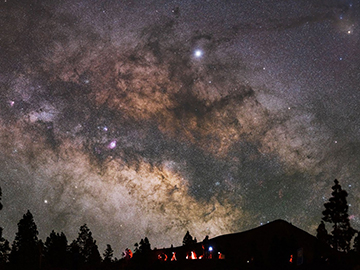Light pollution round the world is making the darkness above the earth “literally disappear,” and taking with it the ability of people across the planet to see the Milky Way stretching over the sky.
As the United States-based National Museum of Natural History explains in a new exhibition “Lights Out: Recovering Our Night Sky,” nearly 80 percent of Americans and 60 percent of Europeans can’t see the “starry band” of light in the night sky.
That’s because the light glow thrown up from buildings, roadways, parking lots, billboards, landscape lighting and countless home outdoor bulbs is disrupting and blotting out the stars, planets and other objects above the Earth.
Earlier, the journal “Science Advances” published in 2016 a “World Atlas of Artificial Light,” which shows that “more than 80 percent of the world and more than 99 percent of the U.S. and European populations live under light-polluted skies.”
Dark pockets where natural night is experienced are becoming the exception, found in the Arctic far north, Antarctica, and the deep interiors of the Amazon and Sahara.
In the Smithsonian Museum magazine, science writer Brian Handwerk notes that “in Europe and the United States, fully 99 percent of the public isn’t able to experience the pleasure of gazing at the stars under natural night-time conditions.”
That wide-spread light pollution is also disrupting the life cycles of birds, insects, flora and other creatures.
As the darkness of night disappears all those plants and animals, including humans, which have lived for millions of years with established patterns of day and night, are being disrupted.
The artificial light humans use is having a negative impact on the ability of animals, plants and insects to feed, rest, migrate and reproduce, even disrupting key activities such as insect and bee pollination.
Like other creatures and species, human beings are guided by a Circadian rhythm, the internal clock which uses light and dark to govern daily cycles like work and rest.
As research has shown, humans suffer from the expanding effects of artificial light.
Darkness helps the body trigger the production of melatonin, the hormone which helps us all sleep, but that sleep can be disrupted by artificial light that blocks melatonin production.
Brian Handwerk notes that studies now showing disruptions to our own circadian rhythms can be linked to a host of health problems, including depression, obesity, heart conditions and even cancer.
“The rapidly growing use of blue light-emitting LED bulbs are especially disruptive of our natural rhythms of rest and activity,” he reports.
Thus, the loss of the night sky goes far beyond human enjoyment of a starry sky.
Yet it is something which is, as one expert notes, “eminently fixable.”
Light shades can redirect light where it’s needed onto the ground and reduce the skyward glow.
LED blue lights can be replaced with warmer-colored LED lights, which are typically strong enough to do the job.
Timers and motion-detection lights can limit the amount of time that unneeded lights are left to simply blaze away, illuminating the darkness of Space.
Dr John Barentine, former director at the International Dark-Sky Association, says that “we already know what policies are demonstrated to work, there is no technical obstacle, we’re not trying to devise a solution.
Our only barrier to implementing it is convincing enough people that there are good reasons to do this.”
The Wairarapa’s communities have overcome that barrier.
“Lights Out: Recovering Our Night Sky” is on view through December 2025 at the Smithsonian’s National Museum of Natural History.
ends



